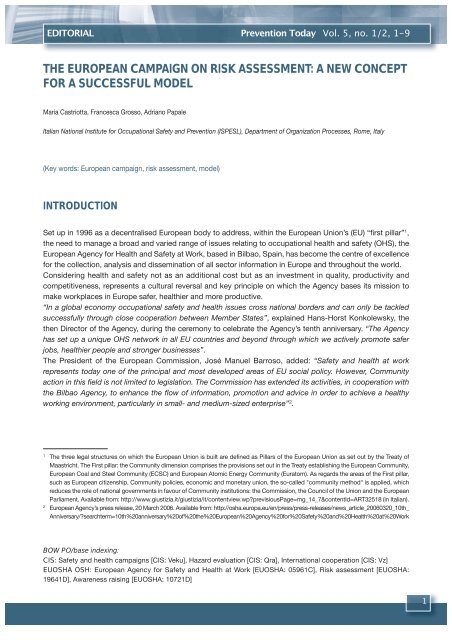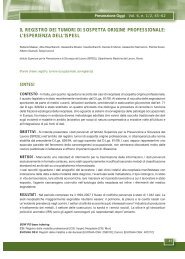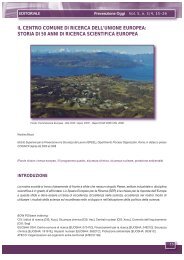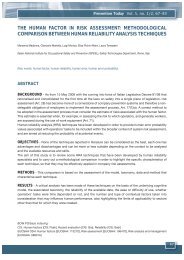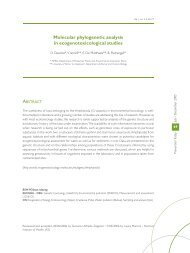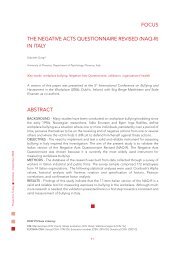Full-text pdf - Prevenzione Oggi - Ispesl
Full-text pdf - Prevenzione Oggi - Ispesl
Full-text pdf - Prevenzione Oggi - Ispesl
Create successful ePaper yourself
Turn your PDF publications into a flip-book with our unique Google optimized e-Paper software.
EDITORIAL Prevention Today Vol. 5, no. 1/2, 1-9<br />
THE EUROPEAN CAMPAIGN ON RISK ASSESSMENT: A NEW CONCEPT<br />
FOR A SUCCESSFUL MODEL<br />
Maria Castriotta, Francesca Grosso, Adriano Papale<br />
Italian National Institute for Occupational Safety and Prevention (ISPESL), Department of Organization Processes, Rome, Italy<br />
(Key words: European campaign, risk assessment, model)<br />
INTRODUCTION<br />
Set up in 1996 as a decentralised European body to address, within the European Union’s (EU) “first pillar” 1 ,<br />
the need to manage a broad and varied range of issues relating to occupational health and safety (OHS), the<br />
European Agency for Health and Safety at Work, based in Bilbao, Spain, has become the centre of excellence<br />
for the collection, analysis and dissemination of all sector information in Europe and throughout the world.<br />
Considering health and safety not as an additional cost but as an investment in quality, productivity and<br />
competitiveness, represents a cultural reversal and key principle on which the Agency bases its mission to<br />
make workplaces in Europe safer, healthier and more productive.<br />
“In a global economy occupational safety and health issues cross national borders and can only be tackled<br />
successfully through close cooperation between Member States”, explained Hans-Horst Konkolewsky, the<br />
then Director of the Agency, during the ceremony to celebrate the Agency’s tenth anniversary. “The Agency<br />
has set up a unique OHS network in all EU countries and beyond through which we actively promote safer<br />
jobs, healthier people and stronger businesses”.<br />
The President of the European Commission, José Manuel Barroso, added: “Safety and health at work<br />
represents today one of the principal and most developed areas of EU social policy. However, Community<br />
action in this field is not limited to legislation. The Commission has extended its activities, in cooperation with<br />
the Bilbao Agency, to enhance the flow of information, promotion and advice in order to achieve a healthy<br />
working environment, particularly in small- and medium-sized enterprise” 2 .<br />
1<br />
The three legal structures on which the European Union is built are defined as Pillars of the European Union as set out by the Treaty of<br />
Maastricht. The First pillar: the Community dimension comprises the provisions set out in the Treaty establishing the European Community,<br />
European Coal and Steel Community (ECSC) and European Atomic Energy Community (Euratom). As regards the areas of the First pillar,<br />
such as European citizenship, Community policies, economic and monetary union, the so-called "community method" is applied, which<br />
reduces the role of national governments in favour of Community institutions: the Commission, the Council of the Union and the European<br />
Parliament. Available from: http://www.giustizia.it/giustizia/it/contentview.wp?previsiousPage=mg_14_7&contentId=ART32518 (in Italian).<br />
2<br />
European Agency’s press release, 20 March 2006. Available from: http://osha.europa.eu/en/press/press-releases/news_article_20060320_10th_<br />
Anniversary/?searchterm=10th%20anniversary%20of%20the%20European%20Agency%20for%20Safety%20and%20Health%20at%20Work<br />
BOW PO/base indexing:<br />
CIS: Safety and health campaigns [CIS: Veku], Hazard evaluation [CIS: Qra], International cooperation [CIS: Vz]<br />
EUOSHA OSH: European Agency for Safety and Health at Work [EUOSHA: 05961C], Risk assessment [EUOSHA:<br />
19641D], Awareness raising [EUOSHA: 10721D]<br />
1
Prevention Today January - June 2009<br />
In line with the duties provided for in its own regulations and Community strategic objectives, in 2000 the<br />
Agency presented its programme of European campaigns with the aim to establish direct contact with work<br />
environments and workers. It also launched its first campaign - Turn your back on musculoskeletal disorders!<br />
- dedicated to preventing musculoskeletal disorders. In the following years, all of Europe - first the so-called<br />
EU15 and then the expanded EU - hosted events and initiatives for campaigns that communicated prevention<br />
messages and disseminated good practice through a creative use of the various languages in the campaign<br />
slogans.<br />
In particular, the European Week for Safety and Health at Work, (held on the 43 rd week of the calendar year)<br />
has become the traditional time of the year for promotional activities. Each year, the campaign’s themes -<br />
identified among the priorities requiring particular actions and systematic measures - have allowed the EU<br />
and Member States to draw attention on specific risk factors, such as noise, stress and dangerous substances;<br />
on sectors with high injury rates, such as construction; or, as in 2006, on a vulnerable group of workers: young<br />
people.<br />
Inspired by a network model and the principles of decentralisation and tripartism, the communication strategy<br />
adopted by the Agency comprises five essential objectives: raising public awareness, providing information,<br />
creating resources and promoting access to them, encouraging activities with a high communication impact<br />
on the workplace, and identifying and transferring good practice.<br />
The Agency’s website contains detailed pages on the campaigns, which are assembled each year with<br />
information, material and online tools that are increasingly technologically advanced and geared to the<br />
campaign’s target audiences. In addition these web pages contain updates on European and national events 3 .<br />
Every campaign ends with the traditional Closing Event in Bilbao in which institutional representatives and EU<br />
experts from Member States conduct and participate in various themed seminars, offering a unique opportunity<br />
for sharing experiences and knowledge, as well as subscribing declarations that lead to commitments and<br />
action programmes aimed at addressing particular risks or intervening in highest risk sectors.<br />
The popular Good Practice Awards ceremony, which is held during the Closing Event, continues to be an<br />
important opportunity to share experiences with other enterprises in Europe that also participate in the Good<br />
Practice Competition and that have distinguished themselves in improving conditions in the workplace; by<br />
virtue of the good practices adopted, these enterprises are awarded a symbolic prize.<br />
The results that have emerged from the detailed assessment reports which accompany each campaign have<br />
generally corresponded to the strategic objectives. Even when taking into account the inevitable differences<br />
in experiences and cultures between countries, it has been observed that there is a common direction to<br />
consolidate the factors leading to success, such as networking, seeking new partners, and the important roles<br />
played by social partners and Focal Points. The top recommendation is the choice of so-called horizontal<br />
themes, which target a wide range of users and also attract those involved in previous campaigns. Another<br />
recommendation is to increase information of national interest in the European Agency’s promotional material.<br />
1. THE EUROPEAN CAMPAIGN ON RISK ASSESSMENT AND THE NEW ITALIAN<br />
CONSOLIDATED ACT ON OCCUPATIONAL HEALTH AND SAFETY<br />
Over time, the European campaigns have become very well-known. In Italy they are coordinated by ISPESLthe<br />
Agency’s Italian Focal Point - in collaboration with the tripartite national network and an ad hoc working<br />
group 4 .<br />
Every year promotional events take place throughout the country, from technical seminars to events aimed at<br />
disseminating the culture of prevention, as well as awareness-raising initiatives promoted by regional bodies,<br />
3<br />
European Agency for Health and Safety at Work. Available from: http://osha.europa.eu<br />
4<br />
Available from: http://www.ispesl.it/ew/<br />
2
The European campaign on risk assessment: a new concept for a successful model<br />
companies, organisations and associations in the sector, which play the key role of “multipliers” of the<br />
campaign message at local level.<br />
The recent approval in Italy of the Consolidated Act on occupational health and safety protection (TU) 5 , which<br />
reorganised, revised and harmonised all the relevant national laws in force, in compliance with Community<br />
directives, has inevitably become the predominant backdrop for all campaign activities.<br />
Indeed, the TU also introduced important innovations concerning risk assessment so that it serves as a primary<br />
pillar in the prevention of occupational accidents and diseases in an even more stringent manner.<br />
Above all, the underlying principle is that the focus is no longer on the company, but on the productive activities<br />
and processes; in this light, it is established that in cases of contracting, sub-contracting, supply and<br />
installation of materials and provision contracts, the principal employer promotes cooperation and coordination<br />
with the contractor and drafts a Unified Interference Risk Assessment Document (DUVRI) 6 .<br />
In addition, the assessment must cover all risks, including specifically those linked to work-related stress,<br />
those concerning pregnant workers and those linked to differences in gender, age and nationality.<br />
Finally, the DUVRI must be dated and must contain the following:<br />
a) a report on the assessment of all health and safety risks, which specifies the criteria adopted for the<br />
assessment;<br />
b) indication of the prevention and protection measures implemented and the personal protective equipment<br />
adopted;<br />
c) the programme of measures necessary to improve safety levels over time;<br />
d) identification of the procedures to implement the measures to be taken and the roles of the company<br />
organisation that must apply these procedures;<br />
e) the name of the prevention and protection service manager, the workers (or local) safety representative,<br />
and the occupational physician involved in the risk assessment;<br />
f) the identification of the tasks that expose workers to specific risks, which require recognised professional<br />
know-how, specific experience, adequate training and preparation 7 .<br />
The European campaign for 2008-2009 is thus part of a national relaunch of risk assessment, as well as of<br />
the further improvement of good practices.<br />
5<br />
Italian Legislative Decree no. 81 of 9 April 2008. Safety Consolidation Act, Implementation of Article 1 of Law no. 123 of 3 August 2007<br />
on the protection of health and safety at work - published in the Official Journal of the Italian Republic no. 101, Ordinary Supplement,<br />
30 April 2008. (In Italian)<br />
6<br />
The Documento Unico di Valutazione dei Rischi da Interferenze (Unified Interference Risk Assessment Document -DUVRI) is required<br />
by Art. 26(3) of Italian Legislative Decree 81/2008 on workplace safety. The compulsory Unified Interference Risk Assessment Report<br />
aims at promoting cooperation and coordination between all contractors operating on the same work site in taking the necessary<br />
measures to eliminate the so-called rischi interferenziali (interference risks), i.e., all the possible risks arising from the interference of<br />
work carried out simultaneously by multiple contractors.<br />
7<br />
Italian Legislative Decree no. 81 of 9 April 2008 op.cit., Art. 28(2) in footnote 5.<br />
3
Prevention Today January - June 2009<br />
Box 1<br />
The most important national events of the European Week for Safety and Health at Work 2008<br />
As part of the Working Environment Convention, under the aegis and financing of the European Agency,<br />
on 8 October 2008 in Modena, the Italian Focal Point and its national network organised the seminar<br />
Risk assessment in SMEs: methods and tools, which provided the opportunity to highlight the problems<br />
in applying risk assessment in small- and medium- sized enterprises (SMEs) and to contribute to the<br />
identification of standardised procedures and models, in light of the new Consolidated Act.<br />
In particular, from 20 to 24 October 2008, Fiumicino’s Leonardo da Vinci Airport hosted the Aeroporti di<br />
Roma (ADR) – ISPESL joint initiative “Journeying through occupational safety”, an innovative and<br />
entertaining way to inform airport personnel about safety in their workplace and to promote a culture of<br />
prevention also among passengers transiting the airport.<br />
ISPESL experts led a programme divided into 4 information sessions focused on specific work risks,<br />
answering questions from interested airport personnel and passengers, using technical tools and handing<br />
out informative material.<br />
In 2008, ISPESL also worked on disseminating the culture of prevention among young people, students,<br />
undergraduates and future workers, by taking part for the first time, together with the Prevention and<br />
Protection Service of University of Rome Tor Vergata, in the student fair Salone dello Studente Campus<br />
Orienta, which took place in Rome from 21 to 23 October 2008.<br />
The aim of the initiative was to actively involve young people and students in the world of occupational<br />
health and safety, to provide answers to their queries and doubts, to acknowledge their rights and learn<br />
their duties, while simultaneously communicating a cultural and scientific message.<br />
The sharing of good practice has always been at the core of the European Agency’s commitment for building<br />
a culture of prevention in Europe. For this reason, as part of each awareness-raising campaign, the Agency<br />
promotes an initiative to collect good practice examples and solutions - on the theme of the campaign - from<br />
various businesses in Member States.<br />
In the past the Agency has highlighted the difficulty in establishing an exact definition for the term “good<br />
practice” also by virtue of the different definitions adopted in various countries.<br />
“Good Practice” information is not easy to define because it is a broad term. It is a wider concept than “best<br />
practice” and covers a large range of information types. It may be simpler to say what good practice is not!<br />
• It is not “research” information.<br />
• It is not “policy” information.<br />
• It is not “general knowledge” for persons who are not exposed to the particular hazard or risk or who do<br />
not operate in the workplace.<br />
The definition of “good practice” varies between Member States due to the different occupational safety and<br />
health systems and legislation, culture, language, and different experiences. In addition, different groups with<br />
different interests and levels of knowledge have different points of view on good practice in the workplace 8 .<br />
The Agency’s working definition is as follows:<br />
Good practice information should provide persons with occupational safety and health duties the information<br />
to allow them to reduce the health and safety risks to workers at enterprise level in the EU.<br />
The information should be of sufficient quality and quantity to produce, following an appropriate assessment<br />
of the hazards and risks present, a permanent and verifiable reduction in the whole potential to cause harm<br />
to all persons affected by the enterprise and ensure that the relevant occupational safety and health legislation<br />
8<br />
European Agency for Safety and Health at Work. Guidelines on the collection, evaluation, and dissemination of good practice information on<br />
the Internet, Bilbao, luglio 2000. Available from : http://www.cna.eu/divisione_economica/dpt_ambiente/SicurezzaLavoro/gp_guidelines.<strong>pdf</strong><br />
4
The European campaign on risk assessment: a new concept for a successful model<br />
is met. The information should be relevant, current, ethical and effective, focusing where possible on preventing<br />
exposure to hazards and risks at source.<br />
Good practice information is implemented most effectively with the strong involvement of all relevant parties<br />
and in particular, those workers and their representatives who will be directly affected by the action taken 9 .<br />
In Italy, a legislative definition of the concept of “good practice” was established for the first time in Legislative<br />
Decree 81/2008, Title I, Article 2(1)(v):<br />
«Good practice»: organisational or procedural solutions, which are compliant with current legislation and<br />
employ good technique; are adopted voluntarily and are aimed at promoting occupational health and safety<br />
by reducing risks and improving working conditions; are developed and collected by the regions, the National<br />
Institute for Occupational Safety and Prevention (ISPESL), the National Institute for Insurance against<br />
Occupational Accidents (INAIL) and the joint bodies as set out in article 51; and are approved by the Permanent<br />
Consultative Committee as per Article 6, subject to a technical review by ISPESL, which ensures its broadest<br />
possible dissemination.<br />
Other provisions of Legislative Decree 81/2008 further define good practice and their approval process:<br />
• Article 6(8) - “The Permanent Consultative Committee for occupational health and safety has the task of:<br />
[…] d) approving good practice in occupational health and safety”;<br />
• Article 9(2) - “ISPESL, INAIL and the Italian Institute of Maritime Social Security act within the competences<br />
assigned to them by law, coordinating the following activities in order that they complement each other<br />
and achieve greater synergy: […] i) development, collection and dissemination of good practice as set out<br />
in Article 2(1)(v)”;<br />
• Article 9(6) - “ISPESL, as part of its institutional competences, operates through its central and local<br />
structures, thus ensuring consistency in the interdisciplinary aspects of its prevention action, and carries<br />
out the following activities: […] o) disseminates, subject to a technical review, good practice as set out in<br />
Article 2(1)(v)”;<br />
• Article 35 - At the periodic meeting “[…] the following can be identified: a) codes of conduct and good<br />
practice to prevent risks of injury and occupational diseases”;<br />
• Article 36 - In training, information and preparation, “the employer shall ensure that each worker is provided<br />
with adequate information: […] b) on risks connected to the use of dangerous substances and preparations<br />
on the basis of the safety data sheets provide for in the legislation in force and in compliance with the<br />
rules of good technique”;<br />
• Article 181 - Physical risk assessment - “1. As part of the assessment as set out in Article 28, the employer<br />
shall assesses all the risks arising from exposure to physical agents so as to identify and adopt the<br />
necessary prevention and protection measures with particular reference to the rules of good technique<br />
and good practice”.<br />
In the above provisions therefore, the regulations explicitly indicate that good practice be developed, collected<br />
and disseminated by the Regions, ISPESL, INAIL and by joint bodies. The duty of the Permanent Consultative<br />
Committee is to approve it. It is clear that ISPESL is fully involved in developing and collecting good practice<br />
by carrying out technical reviews and ensuring its widest possible dissemination.<br />
To support the 2008-2009 European campaign the traditional competition was organised, aiming at collecting<br />
examples of good practice, which culminated in awarding the European winners of the Good Practice Awards<br />
during the Safety and Health at Work in Europe in the 21 st Century congress organised in Prague by the Czech<br />
Presidency of the EU on 27 April 2009. Prizes were awarded to companies and organisations that distinguished<br />
themselves for excellence and innovation in promoting an integrated management approach to risk assessment.<br />
As in every year, ISPESL collected examples of good practice in Italy and conducted a technical review through<br />
a tripartite committee: two examples were put forward for the European Awards (Boxes 2 and 3).<br />
The strength of both these examples of good practice is the aspect of communicating risk, a key element in the<br />
9<br />
Ibid.<br />
5
Prevention Today January - June 2009<br />
risk assessment process and on which attention is focussed also at European level. The techniques for<br />
communicating risk play a fundamental role because they target the effectiveness of information giving and<br />
prevention messages through adequate management of diversity in the workforce in terms of individuals and roles.<br />
Box 2<br />
The first example of good practice selected was submitted by the Prevention and Protection Service of<br />
the Local Health Authority (AUSL) of Piacenza and promotes an innovative and technological method of<br />
communicating risk, focused on the user and on the possibility of accessing information at several levels,<br />
both qualitative (by risk, location and subject) and quantitative (more or less information on the basis of<br />
the level of organisational responsibility).<br />
The focus on the user includes a feedback system:<br />
• voluntary and conducted independently by the user;<br />
• systematic, in the analysis of access data and in the audits planned by the Occupational Safety<br />
Management System with which the communication system is integrated.<br />
The advantages are both internal and external to the system.<br />
Internal advantages:<br />
• assessment uncertainties are reduced because the assessment process has been standardised and<br />
parameterised with the involvement of the team of assessors;<br />
• the assessment is put into a con<strong>text</strong>: the attribution of meaning relates to the time and place of the<br />
assessment.<br />
External advantages:<br />
• the user has information available (risk “traffic light” system) which is coded according to their<br />
information needs from the viewpoint of the type and quantity of information.<br />
Box 3<br />
The second example of good practice was submitted by the Workplace Prevention, Hygiene and Safety<br />
Department of the Local Health and Social Services Authority (ULSS 22) of Bussolengo in the Veneto<br />
Region, and it represents an effective tool to improve the communication of risk and prevention for<br />
immigrant workers.<br />
To address the issue of learning Italian, the project Promossi in classe (passed in class) for immigrant<br />
workers was developed using the Common European Framework of Reference of the Council of Europe<br />
designed to classify the language skills of foreigners. With the collaboration of six companies in the stone<br />
and food sectors, a group of workers was invited to participate in an interview. In addition to their ability<br />
to read independently, three levels of knowledge of the Italian language emerged from the responses<br />
obtained. The first level of knowledge does not ensure the understanding of safety signs and of the<br />
contents of training courses provided by the company. It is fundamental that workers in this group follow<br />
Italian language courses in order to be able to work safely. The second level of knowledge is that of<br />
workers who need to strengthen their basic Italian skills for successful employment and social integration<br />
in Italy. Whereas the third level of knowledge, enables foreign workers to easily follow professional training<br />
and workplace safety courses. If, on the one hand, knowledge of the language is an empowerment tool<br />
for immigrants, on the other, it is also in the direct interests of the employer, who can thus ascertain the<br />
effectiveness of the information and training provided to employees in compliance with Articles 36 and<br />
37 of Legislative Decree 81/2008.<br />
6
The European campaign on risk assessment: a new concept for a successful model<br />
2. THE NETWORK OF PARTNERS AND THE WIN-WIN LOGIC<br />
On 13 June 2008 in Brussels, the Agency launched the ninth edition of the European Campaign - this year on<br />
risk assessment - under a captivating slogan “Healthy Workplaces. Good for you. Good for business”.<br />
As ratified by the European Framework Directive 391 of 1989, risk assessment is the cornerstone of prevention<br />
in the workplace. Hundreds of thousands of companies throughout Europe conduct risk assessments to<br />
protect the health and ensure the safety of their workers, thus reducing costs due to occupational accidents<br />
and diseases and boosting productivity, motivation and competitiveness.<br />
In 2004, a Communication of the European Commission 10 , which examined how the Framework directive and<br />
five of its individual directives have been transposed and implemented, drew the conclusion that there is the<br />
need to improve risk assessment in terms of quality and workers’ participation, in particular in SMEs and in<br />
those sectors where the health and safety acquis still seem particularly lacking.<br />
The Commission’s report identifies the following points to be improved:<br />
• “In the course of superficial, schematic procedures the focus is being put on obvious risks. Long-term<br />
effects (e.g. mental factors) as well as risks that are not easily observed, are being neglected, as for example<br />
those caused by chemical substances.<br />
• There is hardly any consideration of psychosocial risk factors and work organisational factors.<br />
• Risks are not being analysed and evaluated globally. As a consequence, separate measures are being set<br />
in place, but there is no integrative approach for the analysis of the conditions at the workplace.<br />
• Risk assessment is often being considered to be a one-time obligation and lacks continuity.<br />
• The efficiency of the measures is not sufficiently supervised by employers” 11 .<br />
A recent study by the European Agency, which is forthcoming, Workforce diversity and risk assessment:<br />
ensuring everyone is covered, stresses that the risk assessment process is generally affected by the negative<br />
impact of an approach focussed on the so-called standard worker. Workers are not exposed to the same<br />
risks, nor do they perceive the same risk in the same way. Factors linked to gender, work experience, psychophysical<br />
maturity, and country of origin require careful consideration from the outset, i.e., at the point of<br />
preparing the risk assessment document, so that the appropriate prevention measures can then be identified.<br />
The Agency therefore planned the European campaign 2008/2009 by concentrating on the management<br />
approach to risk assessment by communicating concepts of dynamism and simplicity in a five-step process,<br />
which takes the form of a thorough and systematic identification of hazards 12 in the workplace, the elimination<br />
of such hazards where possible, the assessment and control of risks, and the regular monitoring of the<br />
preventative measures adopted. The European Commission has prepared an important guide, Guidance on<br />
risk assessment at work, in order to support Member States and employers and unions in fulfilling the duties<br />
provided for by the Framework Directive for carrying out the risk assessment 13 .<br />
The new model for the campaign runs over a two-year cycle and includes the construction of an official<br />
network of partners participating in the campaign. These two elements are significant innovations that have<br />
contributed to achieve and consolidate the campaign’s success. Further, by looking beyond the central nucleus<br />
of its own networks, seeking out and involving new subjects, and choosing longer periods for planning,<br />
10<br />
Communication from the Commission to the European Parliament, the Council, the European Economic and Social Committee<br />
and the Committee of Regions on the practical implementation of the provisions of the Health and Safety at Work Directives<br />
89/391 (Framework), 89/654 (Workplaces), 89/655 (Work Equipment), 89/656 (Personal Protective Equipment), 90/269 (Manual<br />
Handling of Loads) and 90/270 (Display Screen Equipment). COM(2004) 62 final. Brussels, 5 February 2004. Available from:<br />
http://eur-lex.europa.eu/LexUriServ/LexUriServ.do?uri=COM:2004:0062:FIN:EN:PDF<br />
11<br />
Ibid.<br />
12<br />
There is an important distinction between hazard (any element or factor which may provoke damage) and risk (possibility/probability<br />
of suffering damage due to hazards).<br />
13<br />
European Commission, Directorate-General V, Employment, Industrial Relations and Social Affairs. Luxembourg: Office for Official<br />
Publications of the European Communities; 1996.<br />
7
Prevention Today January - June 2009<br />
preparing, organizing and following-up the campaign, ensures greater effectiveness and increases its impact.<br />
The construction of a network of partners, which operates on a “win-win” basis, was also promoted in Italy in<br />
line with the European model and by investing in the success of the idea of planning. The partners’<br />
commitment in promoting the campaign is matched by the offer of visibility as an official partner and<br />
organisation that is sensitive to occupational health and safety issues.<br />
Supporting the campaign means taking on a European identity within the extended occupational health and<br />
safety community and benefiting from corporate social communication.<br />
Becoming a partner also represents an opportunity not only in terms of information and cultural awareness,<br />
but also to serve as a channel to increase business opportunities and elevate the company’s profile.<br />
On 6 February 2009, the National Day for the Promotion of the Network of Partners - organised by Focal Point<br />
Italy and its national network - was held in the charming historical setting of the Horti Sallustiani in Rome.<br />
Representatives of the institutions, regions, social partners, sector organisations and companies held talks<br />
and committed themselves to the common goal of consolidating an increasingly ethical and cultural model of<br />
occupational health and safety.<br />
The Day did not take the form of a technical seminar on risk assessment, but it was rather an opportunity to<br />
create a support platform for the Campaign, to ask for a formal commitment from all the national stakeholders<br />
and to stimulate the involvement of new partners, in order to implement more widespread initiatives locally<br />
and support activities for companies in risk assessment.<br />
Evoking that communal spirit which in the past enlivened the meetings of Roman emperors in the ancient<br />
Adrianea Hall, the initiative conveyed and enhanced the message of “being together”, in order to construct<br />
an effective and successful campaign.<br />
Among the companies which showed their interest in the partnership project, five officially asked to join it<br />
during the National Day’s proceedings: Air Liquide Welding; OTIS Italia Group; Bovis Lend Lease; ADR<br />
Aeroporti di Roma; Nomentana Hospital.<br />
By completing an online form 14 , it is possible to apply for partnership and set out the planned activities and<br />
strategies to promote the Campaign. Focal Point Italy will then contact the organisations to further discuss<br />
the proposals and then appoint the official partners.<br />
3. THE EUROPEAN CAMPAIGN TOWARDS A MODEL THAT IS INCREASINGLY<br />
PARTICIPATORY AND IN SUPPORT OF SOCIAL DIALOGUE<br />
The current workplace protection policy, by virtue of its complexity and importance of its contents, is without<br />
doubt the result of experiments put forward in the drive for cohesive harmonisation. This process, which is<br />
now complete, has in some ways been measured through traditional regulatory techniques, but it cannot be<br />
considered static and regulated by a predominant bureaucracy. Global competition and the structure of the<br />
world economy have forced innovation and creativity as key factors in achieving social and political progress;<br />
hence the need to network, to join forces and to cooperate with all the players in the health and safety system,<br />
in order to be successful.<br />
The European Agency has inevitably played a crucial role in this plan. Its own international network, and in<br />
particular the tripartite network of Focal Points, have over time contributed not only to consolidate a European<br />
and global wealth of information and resources on occupational health and safety, to exchange and share,<br />
but have also stimulated collective innovations - significantly involving stakeholders - that have taken the form,<br />
in particular, of promotional activities for the European campaigns.<br />
It is also the new EU strategy to invite the Agency, with the support of social partners, “to develop sectoral<br />
awareness-raising campaigns targeted in particular at SMEs, and to promote the management of health and<br />
14<br />
Available from: http://www.ispesl.it/ew/ew2008/partners.asp<br />
8
The European campaign on risk assessment: a new concept for a successful model<br />
safety at work in enterprises through the exchange of experience and good practices aimed at specific sectors.<br />
The social partners are invited to draw up initiatives in the con<strong>text</strong> of the sectoral social dialogue […]” 15 .<br />
The European campaign on risk assessment thus represents the challenge to create new synergies and<br />
becomes the favoured channel for initiatives promoting social dialogue, with the broad participation of<br />
European partners.<br />
It is in particular the recently admitted member states who are demanding work organisation models, technical<br />
solutions, technology and ideas from states which are not only more developed and have a more deeplyrooted<br />
know-how, but are also the main investors in the new areas.<br />
The project Under Construction II - Improving Health and Safety in construction SMEs, promoted by the<br />
European Builders Confederation (EBC), the professional organisation that represents craftsmen and SMEs<br />
in the construction sector in Europe, has successfully focused on the objectives of the initiative promoted by<br />
the campaign.<br />
The project, co-financed by the Commission under the budget heading supporting the European Social<br />
Dialogue, was launched in Brussels on 23 February 2009 and aims at improving health and safety in<br />
construction SMEs through the coordinated approach of social partners.<br />
Thirteen partners from eleven countries (10 EU and Turkey) are involved in this project, including SMEs<br />
associations and trade unions.<br />
Within the general objective of supporting the campaign on risk assessment, the project’s contribution consists<br />
in the dissemination of the campaign’s tools and material as well as exchanging good practice. Finally, the<br />
European social dialogue in the sector is developed through cooperation between national and European<br />
social partners. Thus, communicating an engaged approach to occupational health and safety and promoting<br />
a common culture of prevention have become imperatives, but they must include the broad involvement of all<br />
civil society, which knows no geographical boundaries nor cultural barriers, and goes well beyond the<br />
workplace and workers.<br />
As emerges from the Seoul Declaration 16 , which was signed at the last World Congress on Safety and Health<br />
at Work in Korea by leading figures from the main organisations in the sector, occupational health and safety<br />
is a human right as well as an ethical and social responsibility. Cultural reversal, an underlying principle of the<br />
European Agency’s mission, will become a reality only if the individual as a whole will be at the core of future<br />
policy initiatives in the sector, aiming at quality and total wellbeing and guaranteeing the inalienable principles<br />
of dignity and freedom.<br />
“We have to build and maintain a preventive safety and health culture that permeates all society. Such a culture<br />
must be based on the right to a safe and healthy work environment, on the principle of prevention, and on a<br />
systems approach. Safety and health prevention is not a one-off project - it is continuous, systematic work” 17 .<br />
15<br />
Commission of the European Communities, Communication from the Commission to the European Parliament, the Council, the<br />
European Economic and Social Committee and the Committee of the Regions, COM (2007) 62 final. Improving quality and productivity<br />
at work: Community Strategy 2007-2012 on Health and Safety at Work [online]. Brussels: Office for Official Publications of the European<br />
Communities 2007. Availble from: http://eur-lex.europa.eu/LexUriServ/LexUriServ.do?uri=COM:2007:0062:FIN:en:PDF<br />
16<br />
Seoul Declaration on Safety and Health at Work - The Safety and Health Summit. Available from: http://www.ilo.org/wcmsp5/groups/<br />
public/---dgreports/---dcomm/documents/statement/wcms_095910.<strong>pdf</strong><br />
17<br />
First interview with Jukka Takala, on the day of appointment as director of the European Agency in September 2006. Available from:<br />
http://osha.europa.eu/en/press/press-releases/jukka_takala/<br />
9


